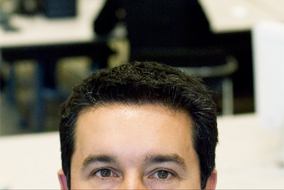
Assist. Prof. Alfred Hermida writes that with a new media culture it is everyday citizens who are writing the first draft of history - photo by Martin Dee UBC Reports | Vol. 53 | No. 10 | Oct. 4, 2007
Stop the Presses!
Ordinary Citizens are Re-writing How News is Reported in a New Media Culture
By Alfred Hermida
Those shaky, slightly blurred few seconds of video, taken by a citizen on a cell phone, capturing a news event as it happened, have become a familiar sight on the TV news. It seems that there is always someone there to record when news breaks, be it a shooting at a US university or a terror attack in Scotland.
The start of this century has seen the advent of citizen media. Technologies such as the Internet and cell phones have empowered the people formerly known as the audience to share their perspective on the world, through blogs, comments, photos and video. In this new media culture, the public is no longer a passive consumer of media, but an active producer of media.
The emergence of what is clumsily described as user-generated content challenges the traditional role of a journalist as the principal conveyor of information. It used to be said that journalists wrote the first draft of history. Now, it is often ordinary citizens who are providing this first draft. It is commonplace to find reports, images and video captured by those on the ground on major news outlets like CBC, CNN or the BBC.
But the mainstream media has only recently embraced citizen media. In the UK, it took the London bombings of July 2005 to make news outlets take note. The tragic events were captured in words, photos and video by people caught up in the event. The iconic images of that day came from the public, not from professional photographers.
The BBC alone received 22,000 e-mails and text messages on the day, as well as 300 amateur photos and several video sequences. The dramatic stills and video of the chaos inside the underground tunnels led BBC TV newscasts that evening. This was the first time such material had been considered more newsworthy than professional content. The images recorded on low-resolution cell phone cameras helped to shed light on the attacks in a way that would not have been possible before.
The July bombings were a watershed moment for citizen media and its acceptance by the mainstream media in Britain. The BBC News website had in fact been soliciting comments from its audience since its inception in 1997, expanding this to photos and eyewitness accounts a few years later. But 2005 was the year that editors at the BBC, and at other major news outlets, woke up to the full potential of user-generated content.
In the months that followed the July bombings, virtually every major UK newspaper started to engage in greater interaction with their readers.
The London bombings also played a role in taking citizen media out of the hands of the early adopters and putting it in those of the masses. The acres of analysis and explanation in newspapers, TV and radio helped to educate the public for their new role as citizen reporters.
When, just two weeks after the first attacks, there was a series of attempted bombings in London, it was almost as if people knew what was expected of them. Since then, every time news breaks, the British public has been on hand to provide first-hand reports.
Just as the July 2005 bombings were a seminal moment for participatory journalism in the UK, the shootings at Virginia Tech in April this year may well have been that moment for the US. A student, Jamal Albaughouti, took the most striking material on his cell phone.
The low quality video showed a campus devoid of students. But the sound he recorded of gunshots echoing across the campus brought home the horror of the shootings. By the end of the day, it was broadcast to an audience of millions on the main US news stations.
The Virginia Tech shootings were widely heralded as one of those cornerstone events in participatory journalism in the US. In August, when the Minneapolis I-35W bridge collapsed, citizen media jumped into action immediately, writing blog entries, uploading images and video to sharing sites like Flickr and YouTube, working alongside, as well as together with, the mainstream media.
When news breaks, reports, images and video captured by those on the ground help to create a mosaic of amateur and professional news coverage. Just about every news organization now turns to readers and viewers for their help in covering the news.
The mainstream media has accepted that having a public engaged in the newsgathering process can enhance its reporting -- but it still wields editorial control. Professional editors vet images and information from viewers and listeners. Almost all of the mainstream media treat citizens as a resource for reporters, rather than treating as equals who can tell stories themselves.
But the torrent of material from the public is helping to shape the coverage of major news stories. In some cases, decisions on where to send reporters are being driven by the personal stories of those caught up in the news. During the summer floods in Britain, the torrent of information from the public has helped form the BBC’s coverage, influencing where reporters and camera crews were dispatched. Technology is irrevocably changing the way news is reported, how it is reported and who is reporting it.
Alfred Hermida is an assistant professor at the UBC School of Journalism and a former founding member of BBCNews.com.
|
